Summer 2017 MAII3007 Numeracy 2 Portfolio Assignment - Economics
VerifiedAdded on 2020/04/13
|17
|2897
|56
Homework Assignment
AI Summary
This document presents a solved portfolio assignment for the Numeracy 2 module (MAII3007) from Summer 2017. The assignment covers a range of mathematical concepts relevant to economics and business, including powers, roots, simple and compound interest calculations, and the application of the Rule of 72. It delves into linear relationships, solving equations, and interpreting data through scatter plots. Furthermore, the portfolio explores financial concepts such as Net Present Value (NPV) and its application in investment decisions. The assignment also includes data analysis through histograms and probability calculations, providing real-world examples of how these concepts are used in business contexts. The solution provides step-by-step workings and explanations for each question, demonstrating the application of these concepts and their practical implications.
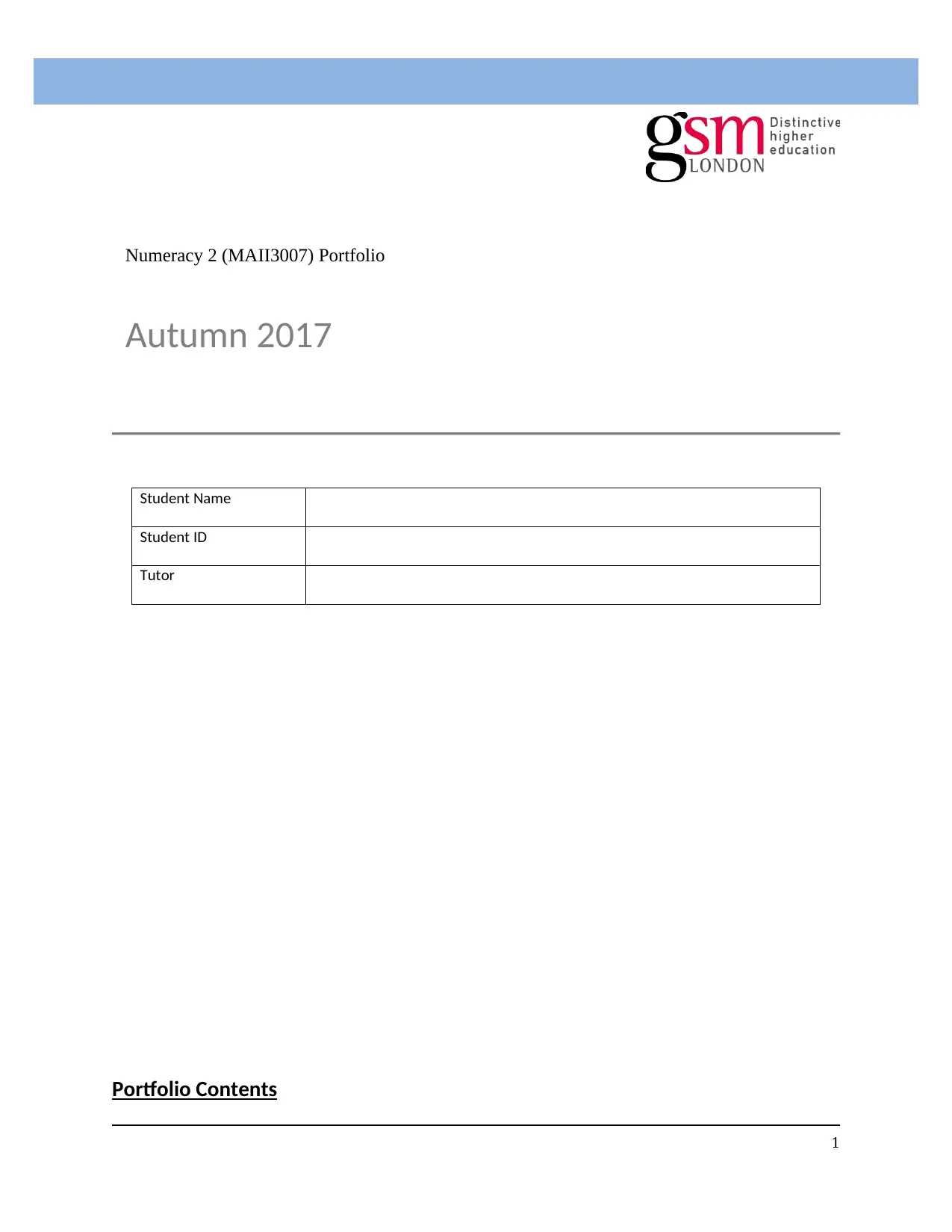
Student Name
Student ID
Tutor
Portfolio Contents
1
Numeracy 2 (MAII3007) Portfolio
Autumn 2017
Student ID
Tutor
Portfolio Contents
1
Numeracy 2 (MAII3007) Portfolio
Autumn 2017
Paraphrase This Document
Need a fresh take? Get an instant paraphrase of this document with our AI Paraphraser
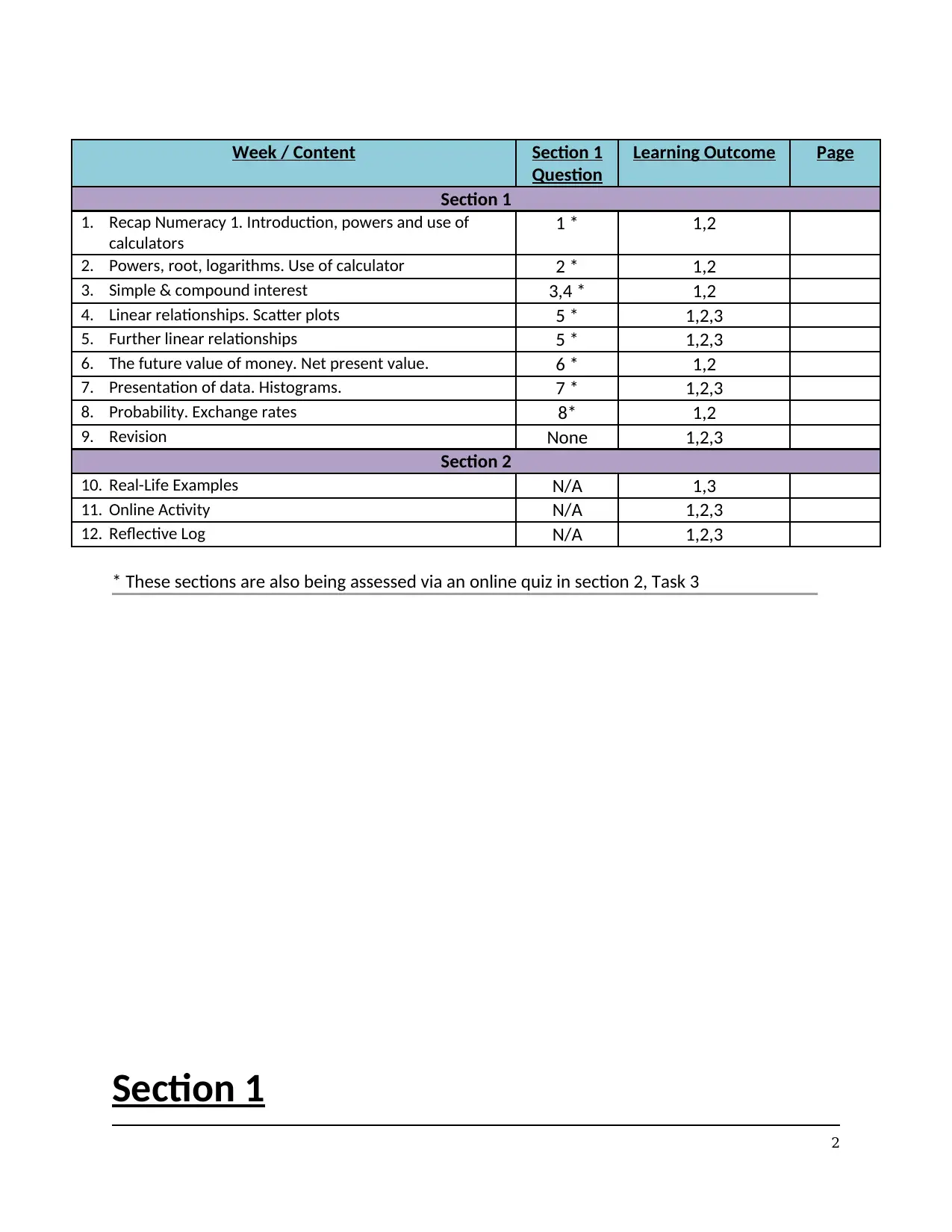
Week / Content Section 1
Question
Learning Outcome Page
Section 1
1. Recap Numeracy 1. Introduction, powers and use of
calculators
1 * 1,2
2. Powers, root, logarithms. Use of calculator 2 * 1,2
3. Simple & compound interest 3,4 * 1,2
4. Linear relationships. Scatter plots 5 * 1,2,3
5. Further linear relationships 5 * 1,2,3
6. The future value of money. Net present value. 6 * 1,2
7. Presentation of data. Histograms. 7 * 1,2,3
8. Probability. Exchange rates 8* 1,2
9. Revision None 1,2,3
Section 2
10. Real-Life Examples N/A 1,3
11. Online Activity N/A 1,2,3
12. Reflective Log N/A 1,2,3
* These sections are also being assessed via an online quiz in section 2, Task 3
Section 1
2
Question
Learning Outcome Page
Section 1
1. Recap Numeracy 1. Introduction, powers and use of
calculators
1 * 1,2
2. Powers, root, logarithms. Use of calculator 2 * 1,2
3. Simple & compound interest 3,4 * 1,2
4. Linear relationships. Scatter plots 5 * 1,2,3
5. Further linear relationships 5 * 1,2,3
6. The future value of money. Net present value. 6 * 1,2
7. Presentation of data. Histograms. 7 * 1,2,3
8. Probability. Exchange rates 8* 1,2
9. Revision None 1,2,3
Section 2
10. Real-Life Examples N/A 1,3
11. Online Activity N/A 1,2,3
12. Reflective Log N/A 1,2,3
* These sections are also being assessed via an online quiz in section 2, Task 3
Section 1
2
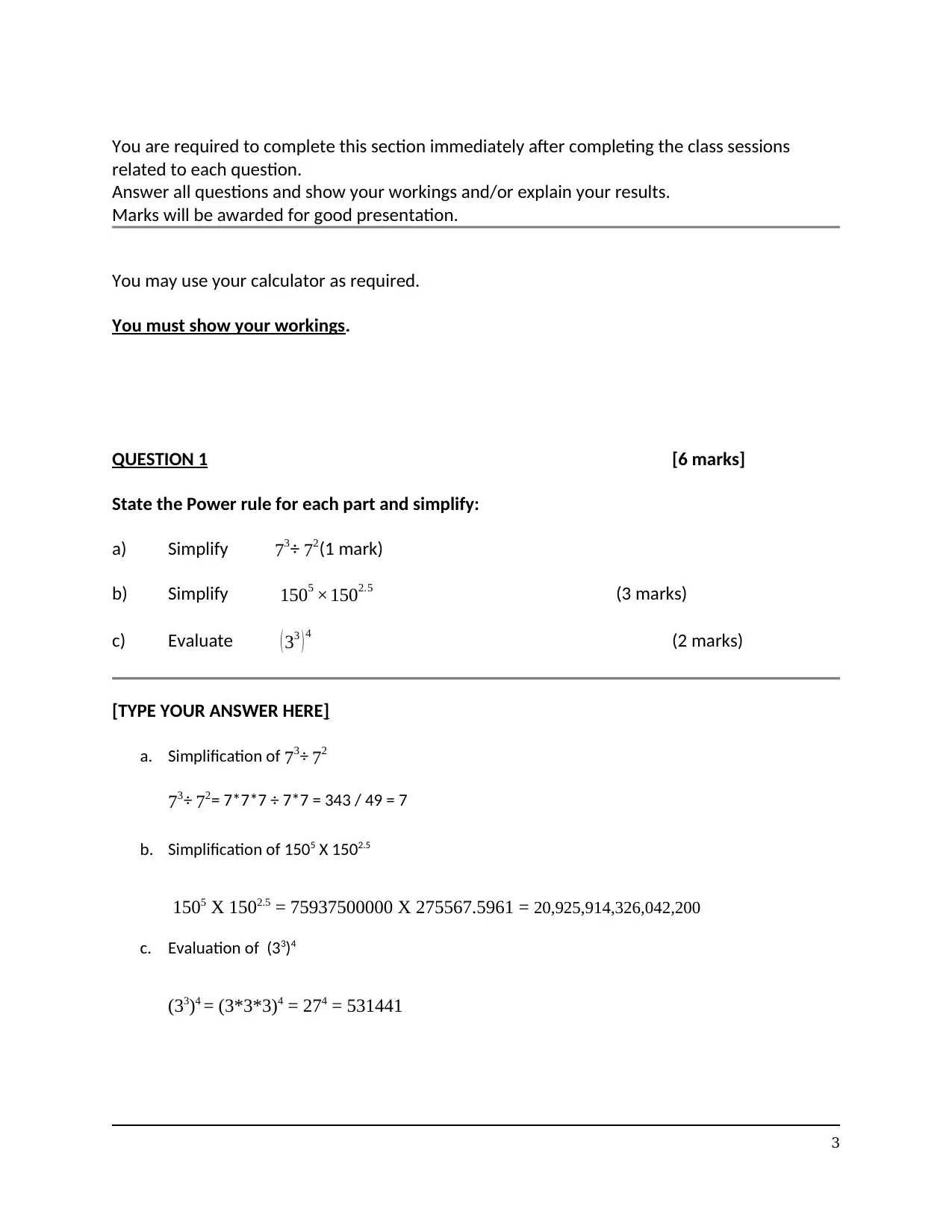
You are required to complete this section immediately after completing the class sessions
related to each question.
Answer all questions and show your workings and/or explain your results.
Marks will be awarded for good presentation.
You may use your calculator as required.
You must show your workings.
QUESTION 1 [6 marks]
State the Power rule for each part and simplify:
a) Simplify 73÷ 72(1 mark)
b) Simplify 1505 ×1502.5 (3 marks)
c) Evaluate ( 33 ) 4 (2 marks)
[TYPE YOUR ANSWER HERE]
a. Simplification of 73÷ 72
73÷ 72= 7*7*7 ÷ 7*7 = 343 / 49 = 7
b. Simplification of 1505 X 1502.5
1505 X 1502.5 = 75937500000 X 275567.5961 = 20,925,914,326,042,200
c. Evaluation of (33)4
(33)4 = (3*3*3)4 = 274 = 531441
3
related to each question.
Answer all questions and show your workings and/or explain your results.
Marks will be awarded for good presentation.
You may use your calculator as required.
You must show your workings.
QUESTION 1 [6 marks]
State the Power rule for each part and simplify:
a) Simplify 73÷ 72(1 mark)
b) Simplify 1505 ×1502.5 (3 marks)
c) Evaluate ( 33 ) 4 (2 marks)
[TYPE YOUR ANSWER HERE]
a. Simplification of 73÷ 72
73÷ 72= 7*7*7 ÷ 7*7 = 343 / 49 = 7
b. Simplification of 1505 X 1502.5
1505 X 1502.5 = 75937500000 X 275567.5961 = 20,925,914,326,042,200
c. Evaluation of (33)4
(33)4 = (3*3*3)4 = 274 = 531441
3
⊘ This is a preview!⊘
Do you want full access?
Subscribe today to unlock all pages.

Trusted by 1+ million students worldwide
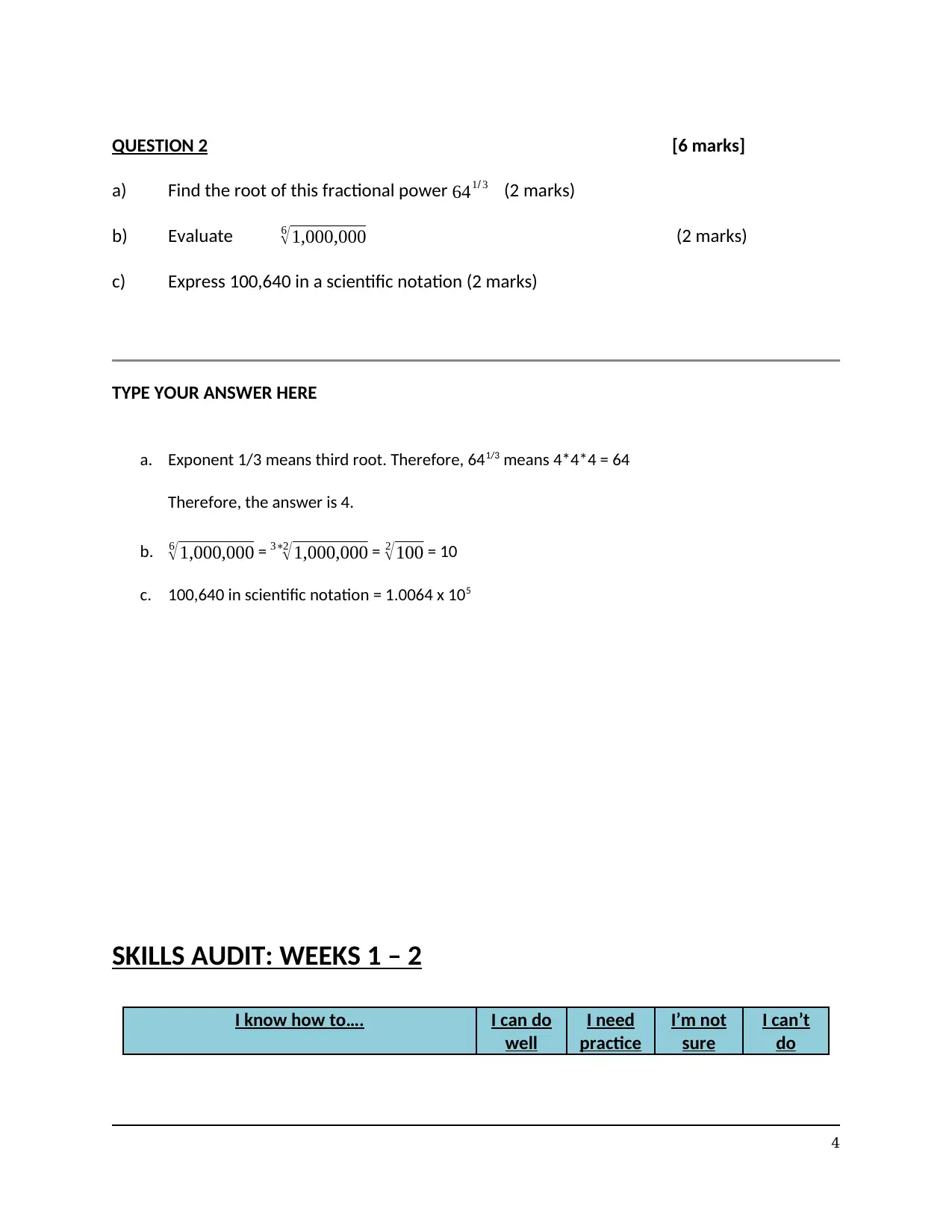
QUESTION 2 [6 marks]
a) Find the root of this fractional power 641/ 3 (2 marks)
b) Evaluate 6
√ 1,000,000 (2 marks)
c) Express 100,640 in a scientific notation (2 marks)
TYPE YOUR ANSWER HERE
a. Exponent 1/3 means third root. Therefore, 641/3 means 4*4*4 = 64
Therefore, the answer is 4.
b. 6
√ 1,000,000 = 3∗2
√1,000,000 = 2
√100 = 10
c. 100,640 in scientific notation = 1.0064 x 105
SKILLS AUDIT: WEEKS 1 – 2
I know how to…. I can do
well
I need
practice
I’m not
sure
I can’t
do
4
a) Find the root of this fractional power 641/ 3 (2 marks)
b) Evaluate 6
√ 1,000,000 (2 marks)
c) Express 100,640 in a scientific notation (2 marks)
TYPE YOUR ANSWER HERE
a. Exponent 1/3 means third root. Therefore, 641/3 means 4*4*4 = 64
Therefore, the answer is 4.
b. 6
√ 1,000,000 = 3∗2
√1,000,000 = 2
√100 = 10
c. 100,640 in scientific notation = 1.0064 x 105
SKILLS AUDIT: WEEKS 1 – 2
I know how to…. I can do
well
I need
practice
I’m not
sure
I can’t
do
4
Paraphrase This Document
Need a fresh take? Get an instant paraphrase of this document with our AI Paraphraser
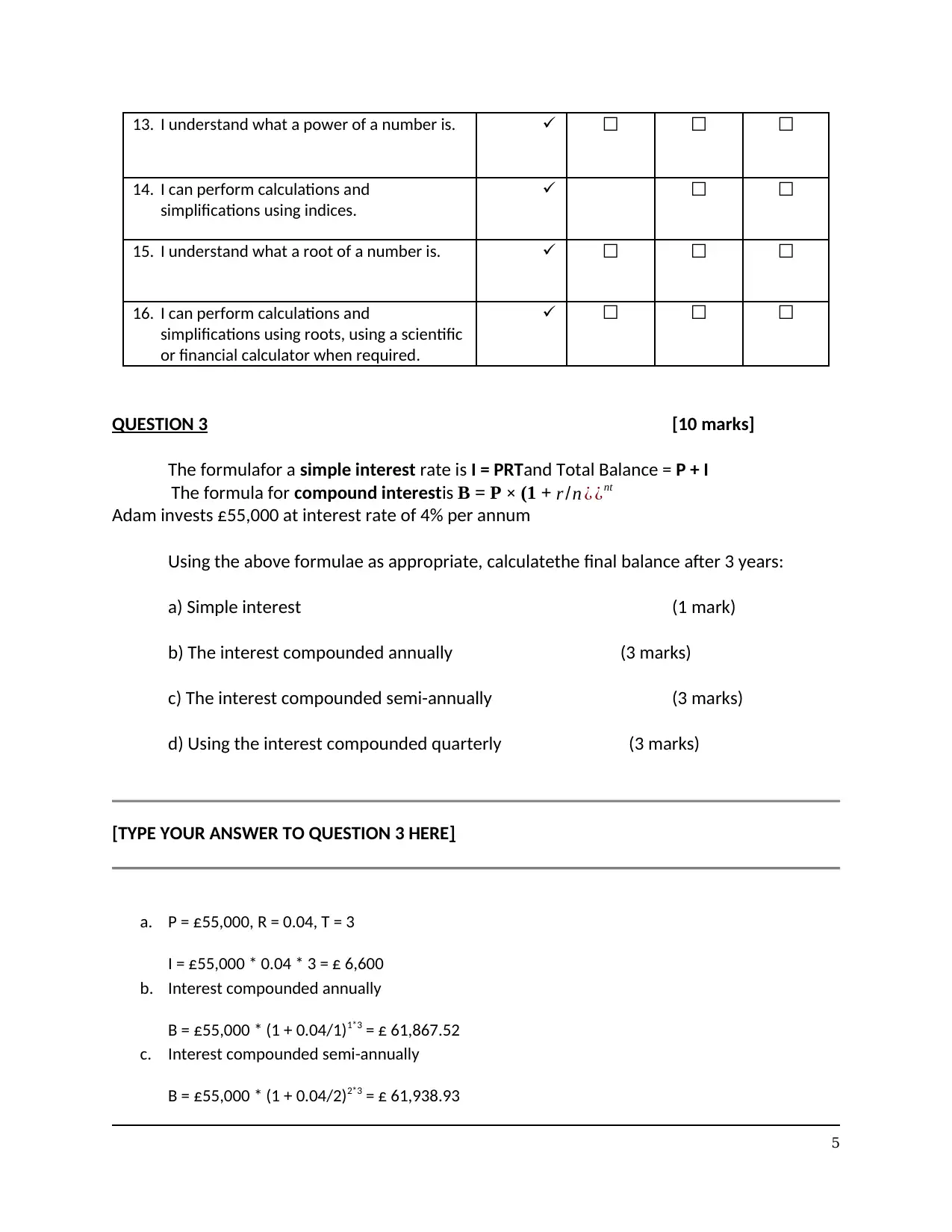
13. I understand what a power of a number is. ☐ ☐ ☐
14. I can perform calculations and
simplifications using indices.
☐ ☐
15. I understand what a root of a number is. ☐ ☐ ☐
16. I can perform calculations and
simplifications using roots, using a scientific
or financial calculator when required.
☐ ☐ ☐
QUESTION 3 [10 marks]
The formulafor a simple interest rate is I = PRTand Total Balance = P + I
The formula for compound interestis B = P × (1 + r /n ¿ ¿nt
Adam invests £55,000 at interest rate of 4% per annum
Using the above formulae as appropriate, calculatethe final balance after 3 years:
a) Simple interest (1 mark)
b) The interest compounded annually (3 marks)
c) The interest compounded semi-annually (3 marks)
d) Using the interest compounded quarterly (3 marks)
[TYPE YOUR ANSWER TO QUESTION 3 HERE]
a. P = £55,000, R = 0.04, T = 3
I = £55,000 * 0.04 * 3 = £ 6,600
b. Interest compounded annually
B = £55,000 * (1 + 0.04/1)1*3 = £ 61,867.52
c. Interest compounded semi-annually
B = £55,000 * (1 + 0.04/2)2*3 = £ 61,938.93
5
14. I can perform calculations and
simplifications using indices.
☐ ☐
15. I understand what a root of a number is. ☐ ☐ ☐
16. I can perform calculations and
simplifications using roots, using a scientific
or financial calculator when required.
☐ ☐ ☐
QUESTION 3 [10 marks]
The formulafor a simple interest rate is I = PRTand Total Balance = P + I
The formula for compound interestis B = P × (1 + r /n ¿ ¿nt
Adam invests £55,000 at interest rate of 4% per annum
Using the above formulae as appropriate, calculatethe final balance after 3 years:
a) Simple interest (1 mark)
b) The interest compounded annually (3 marks)
c) The interest compounded semi-annually (3 marks)
d) Using the interest compounded quarterly (3 marks)
[TYPE YOUR ANSWER TO QUESTION 3 HERE]
a. P = £55,000, R = 0.04, T = 3
I = £55,000 * 0.04 * 3 = £ 6,600
b. Interest compounded annually
B = £55,000 * (1 + 0.04/1)1*3 = £ 61,867.52
c. Interest compounded semi-annually
B = £55,000 * (1 + 0.04/2)2*3 = £ 61,938.93
5

d. Interest compounded quarterly
B = £55,000 * (1 + 0.04/4)4*3 = £ 61,975.38
6
B = £55,000 * (1 + 0.04/4)4*3 = £ 61,975.38
6
⊘ This is a preview!⊘
Do you want full access?
Subscribe today to unlock all pages.

Trusted by 1+ million students worldwide
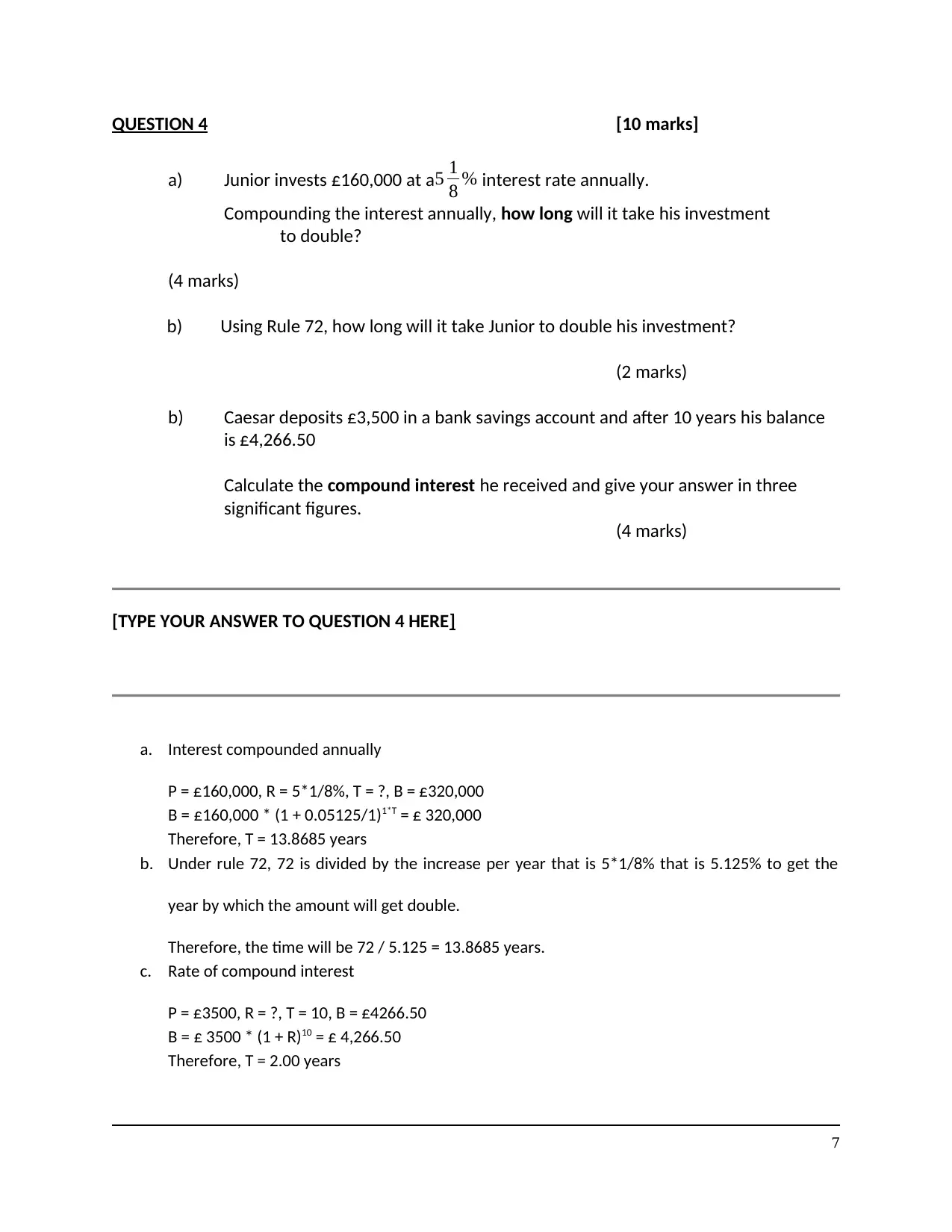
QUESTION 4 [10 marks]
a) Junior invests £160,000 at a5 1
8 % interest rate annually.
Compounding the interest annually, how long will it take his investment
to double?
(4 marks)
b) Using Rule 72, how long will it take Junior to double his investment?
(2 marks)
b) Caesar deposits £3,500 in a bank savings account and after 10 years his balance
is £4,266.50
Calculate the compound interest he received and give your answer in three
significant figures.
(4 marks)
[TYPE YOUR ANSWER TO QUESTION 4 HERE]
a. Interest compounded annually
P = £160,000, R = 5*1/8%, T = ?, B = £320,000
B = £160,000 * (1 + 0.05125/1)1*T = £ 320,000
Therefore, T = 13.8685 years
b. Under rule 72, 72 is divided by the increase per year that is 5*1/8% that is 5.125% to get the
year by which the amount will get double.
Therefore, the time will be 72 / 5.125 = 13.8685 years.
c. Rate of compound interest
P = £3500, R = ?, T = 10, B = £4266.50
B = £ 3500 * (1 + R)10 = £ 4,266.50
Therefore, T = 2.00 years
7
a) Junior invests £160,000 at a5 1
8 % interest rate annually.
Compounding the interest annually, how long will it take his investment
to double?
(4 marks)
b) Using Rule 72, how long will it take Junior to double his investment?
(2 marks)
b) Caesar deposits £3,500 in a bank savings account and after 10 years his balance
is £4,266.50
Calculate the compound interest he received and give your answer in three
significant figures.
(4 marks)
[TYPE YOUR ANSWER TO QUESTION 4 HERE]
a. Interest compounded annually
P = £160,000, R = 5*1/8%, T = ?, B = £320,000
B = £160,000 * (1 + 0.05125/1)1*T = £ 320,000
Therefore, T = 13.8685 years
b. Under rule 72, 72 is divided by the increase per year that is 5*1/8% that is 5.125% to get the
year by which the amount will get double.
Therefore, the time will be 72 / 5.125 = 13.8685 years.
c. Rate of compound interest
P = £3500, R = ?, T = 10, B = £4266.50
B = £ 3500 * (1 + R)10 = £ 4,266.50
Therefore, T = 2.00 years
7
Paraphrase This Document
Need a fresh take? Get an instant paraphrase of this document with our AI Paraphraser
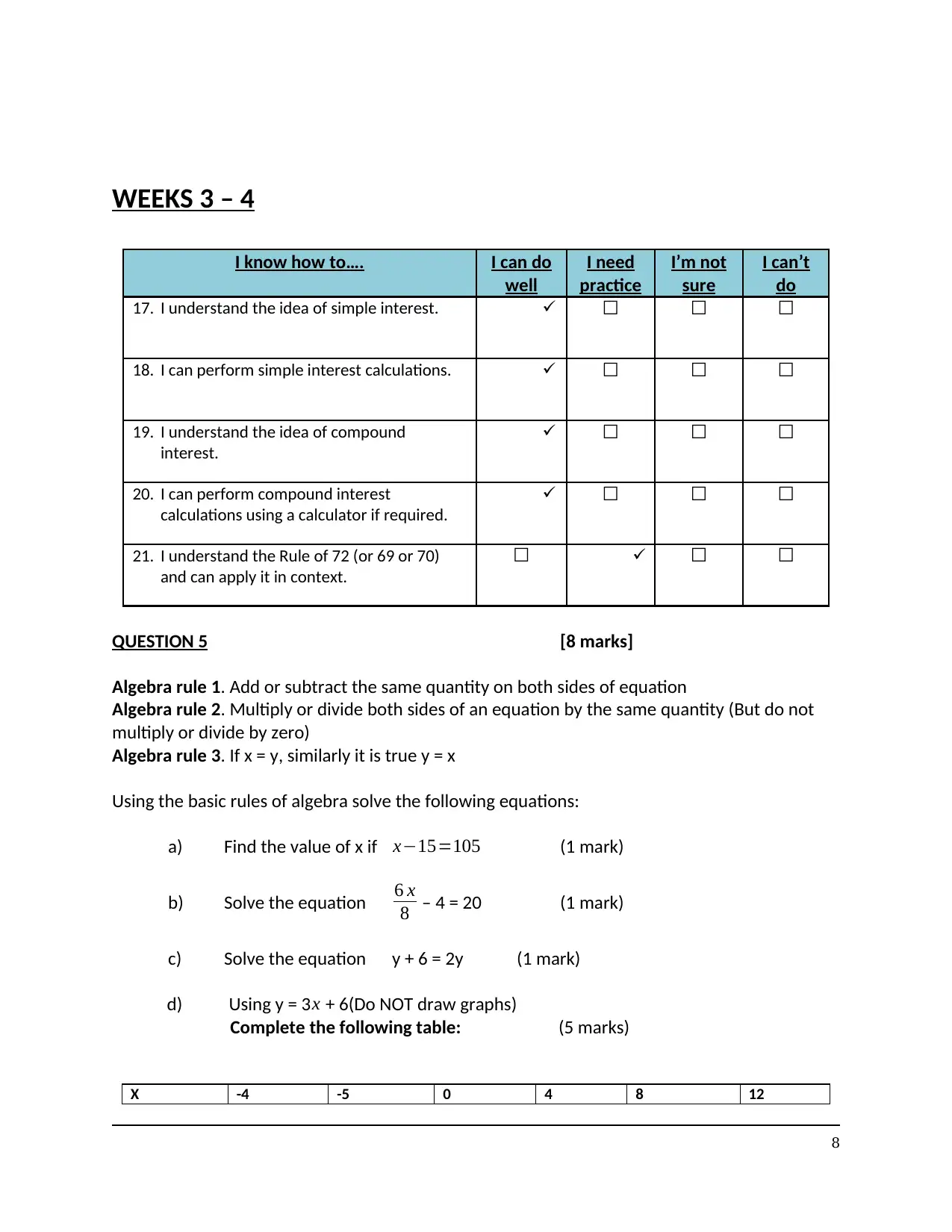
WEEKS 3 – 4
I know how to…. I can do
well
I need
practice
I’m not
sure
I can’t
do
17. I understand the idea of simple interest. ☐ ☐ ☐
18. I can perform simple interest calculations. ☐ ☐ ☐
19. I understand the idea of compound
interest.
☐ ☐ ☐
20. I can perform compound interest
calculations using a calculator if required.
☐ ☐ ☐
21. I understand the Rule of 72 (or 69 or 70)
and can apply it in context.
☐ ☐ ☐
QUESTION 5 [8 marks]
Algebra rule 1. Add or subtract the same quantity on both sides of equation
Algebra rule 2. Multiply or divide both sides of an equation by the same quantity (But do not
multiply or divide by zero)
Algebra rule 3. If x = y, similarly it is true y = x
Using the basic rules of algebra solve the following equations:
a) Find the value of x if x−15=105 (1 mark)
b) Solve the equation 6 x
8 – 4 = 20 (1 mark)
c) Solve the equation y + 6 = 2y (1 mark)
d) Using y = 3 x + 6(Do NOT draw graphs)
Complete the following table: (5 marks)
X -4 -5 0 4 8 12
8
I know how to…. I can do
well
I need
practice
I’m not
sure
I can’t
do
17. I understand the idea of simple interest. ☐ ☐ ☐
18. I can perform simple interest calculations. ☐ ☐ ☐
19. I understand the idea of compound
interest.
☐ ☐ ☐
20. I can perform compound interest
calculations using a calculator if required.
☐ ☐ ☐
21. I understand the Rule of 72 (or 69 or 70)
and can apply it in context.
☐ ☐ ☐
QUESTION 5 [8 marks]
Algebra rule 1. Add or subtract the same quantity on both sides of equation
Algebra rule 2. Multiply or divide both sides of an equation by the same quantity (But do not
multiply or divide by zero)
Algebra rule 3. If x = y, similarly it is true y = x
Using the basic rules of algebra solve the following equations:
a) Find the value of x if x−15=105 (1 mark)
b) Solve the equation 6 x
8 – 4 = 20 (1 mark)
c) Solve the equation y + 6 = 2y (1 mark)
d) Using y = 3 x + 6(Do NOT draw graphs)
Complete the following table: (5 marks)
X -4 -5 0 4 8 12
8
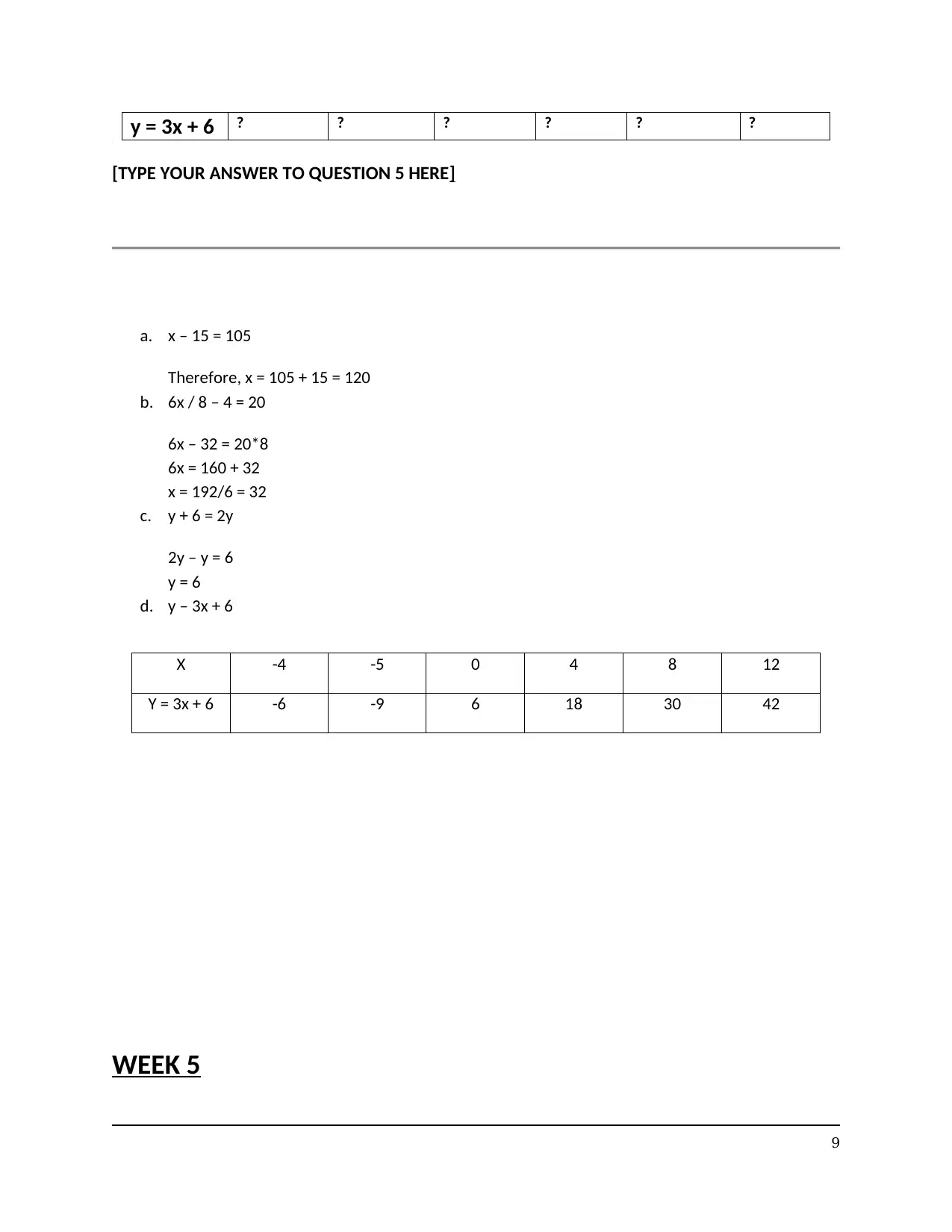
y = 3x + 6 ? ? ? ? ? ?
[TYPE YOUR ANSWER TO QUESTION 5 HERE]
a. x – 15 = 105
Therefore, x = 105 + 15 = 120
b. 6x / 8 – 4 = 20
6x – 32 = 20*8
6x = 160 + 32
x = 192/6 = 32
c. y + 6 = 2y
2y – y = 6
y = 6
d. y – 3x + 6
X -4 -5 0 4 8 12
Y = 3x + 6 -6 -9 6 18 30 42
WEEK 5
9
[TYPE YOUR ANSWER TO QUESTION 5 HERE]
a. x – 15 = 105
Therefore, x = 105 + 15 = 120
b. 6x / 8 – 4 = 20
6x – 32 = 20*8
6x = 160 + 32
x = 192/6 = 32
c. y + 6 = 2y
2y – y = 6
y = 6
d. y – 3x + 6
X -4 -5 0 4 8 12
Y = 3x + 6 -6 -9 6 18 30 42
WEEK 5
9
⊘ This is a preview!⊘
Do you want full access?
Subscribe today to unlock all pages.

Trusted by 1+ million students worldwide
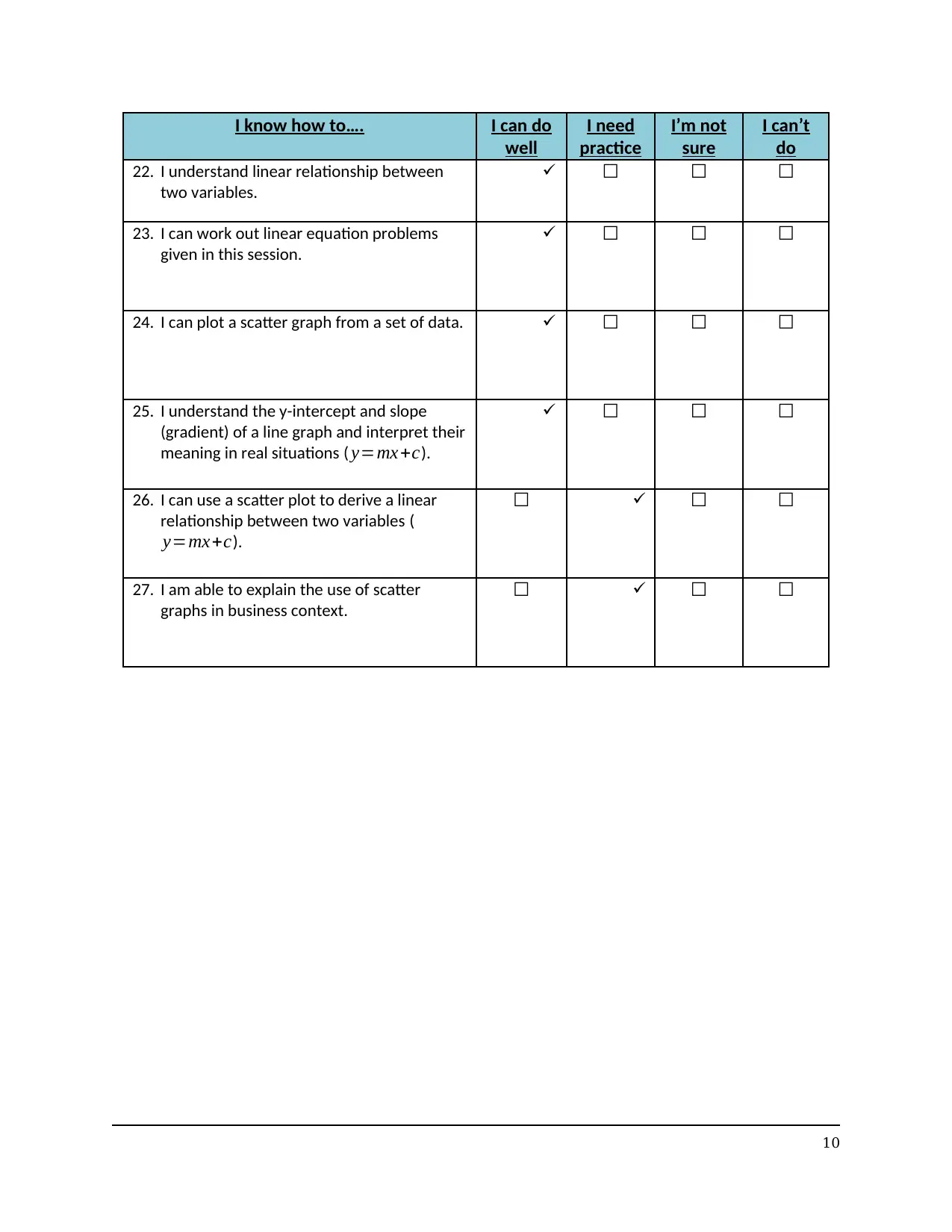
I know how to…. I can do
well
I need
practice
I’m not
sure
I can’t
do
22. I understand linear relationship between
two variables.
☐ ☐ ☐
23. I can work out linear equation problems
given in this session.
☐ ☐ ☐
24. I can plot a scatter graph from a set of data. ☐ ☐ ☐
25. I understand the y-intercept and slope
(gradient) of a line graph and interpret their
meaning in real situations ( y=mx+c).
☐ ☐ ☐
26. I can use a scatter plot to derive a linear
relationship between two variables (
y=mx+c).
☐ ☐ ☐
27. I am able to explain the use of scatter
graphs in business context.
☐ ☐ ☐
10
well
I need
practice
I’m not
sure
I can’t
do
22. I understand linear relationship between
two variables.
☐ ☐ ☐
23. I can work out linear equation problems
given in this session.
☐ ☐ ☐
24. I can plot a scatter graph from a set of data. ☐ ☐ ☐
25. I understand the y-intercept and slope
(gradient) of a line graph and interpret their
meaning in real situations ( y=mx+c).
☐ ☐ ☐
26. I can use a scatter plot to derive a linear
relationship between two variables (
y=mx+c).
☐ ☐ ☐
27. I am able to explain the use of scatter
graphs in business context.
☐ ☐ ☐
10
Paraphrase This Document
Need a fresh take? Get an instant paraphrase of this document with our AI Paraphraser
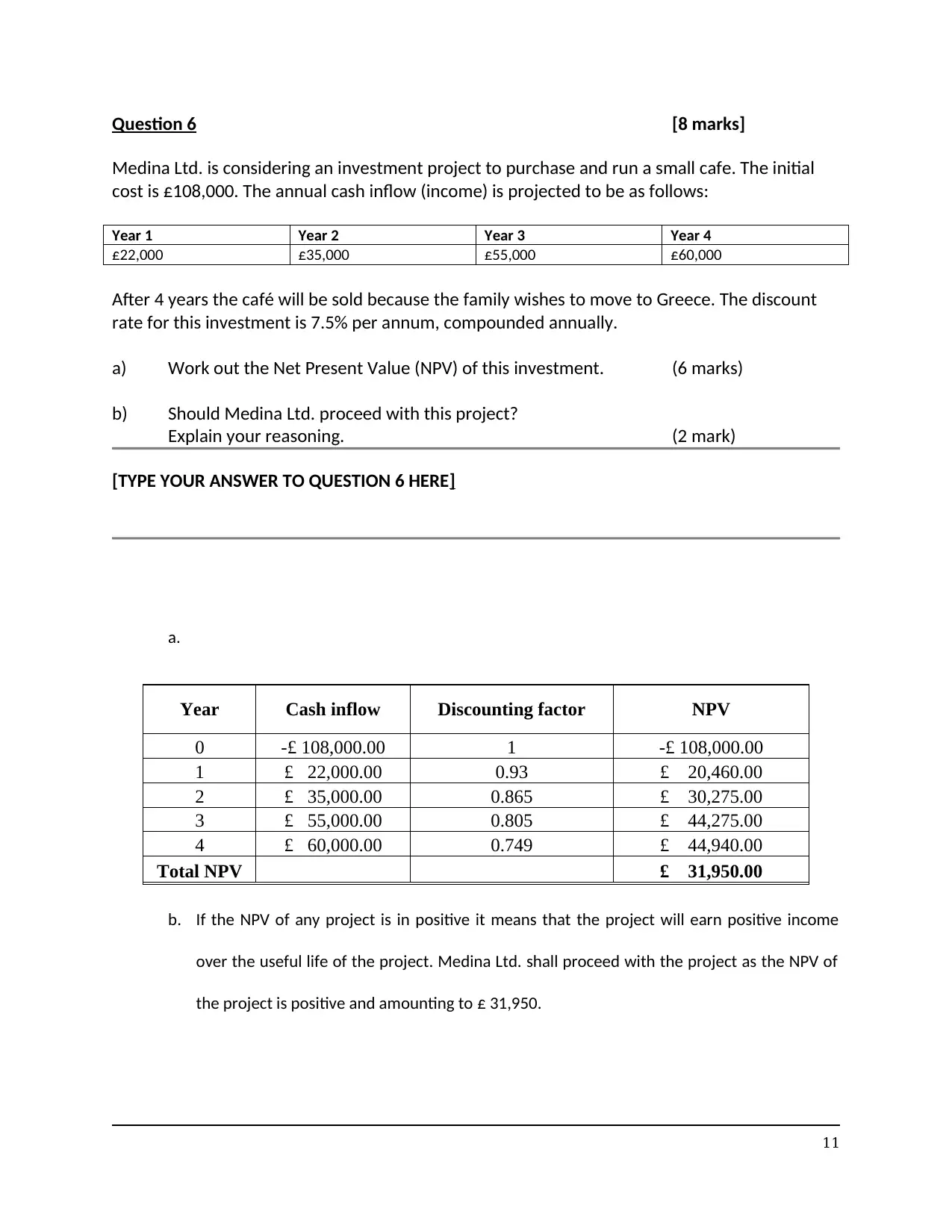
Question 6 [8 marks]
Medina Ltd. is considering an investment project to purchase and run a small cafe. The initial
cost is £108,000. The annual cash inflow (income) is projected to be as follows:
Year 1 Year 2 Year 3 Year 4
£22,000 £35,000 £55,000 £60,000
After 4 years the café will be sold because the family wishes to move to Greece. The discount
rate for this investment is 7.5% per annum, compounded annually.
a) Work out the Net Present Value (NPV) of this investment. (6 marks)
b) Should Medina Ltd. proceed with this project?
Explain your reasoning. (2 mark)
[TYPE YOUR ANSWER TO QUESTION 6 HERE]
a.
Year Cash inflow Discounting factor NPV
0 -£ 108,000.00 1 -£ 108,000.00
1 £ 22,000.00 0.93 £ 20,460.00
2 £ 35,000.00 0.865 £ 30,275.00
3 £ 55,000.00 0.805 £ 44,275.00
4 £ 60,000.00 0.749 £ 44,940.00
Total NPV £ 31,950.00
b. If the NPV of any project is in positive it means that the project will earn positive income
over the useful life of the project. Medina Ltd. shall proceed with the project as the NPV of
the project is positive and amounting to £ 31,950.
11
Medina Ltd. is considering an investment project to purchase and run a small cafe. The initial
cost is £108,000. The annual cash inflow (income) is projected to be as follows:
Year 1 Year 2 Year 3 Year 4
£22,000 £35,000 £55,000 £60,000
After 4 years the café will be sold because the family wishes to move to Greece. The discount
rate for this investment is 7.5% per annum, compounded annually.
a) Work out the Net Present Value (NPV) of this investment. (6 marks)
b) Should Medina Ltd. proceed with this project?
Explain your reasoning. (2 mark)
[TYPE YOUR ANSWER TO QUESTION 6 HERE]
a.
Year Cash inflow Discounting factor NPV
0 -£ 108,000.00 1 -£ 108,000.00
1 £ 22,000.00 0.93 £ 20,460.00
2 £ 35,000.00 0.865 £ 30,275.00
3 £ 55,000.00 0.805 £ 44,275.00
4 £ 60,000.00 0.749 £ 44,940.00
Total NPV £ 31,950.00
b. If the NPV of any project is in positive it means that the project will earn positive income
over the useful life of the project. Medina Ltd. shall proceed with the project as the NPV of
the project is positive and amounting to £ 31,950.
11
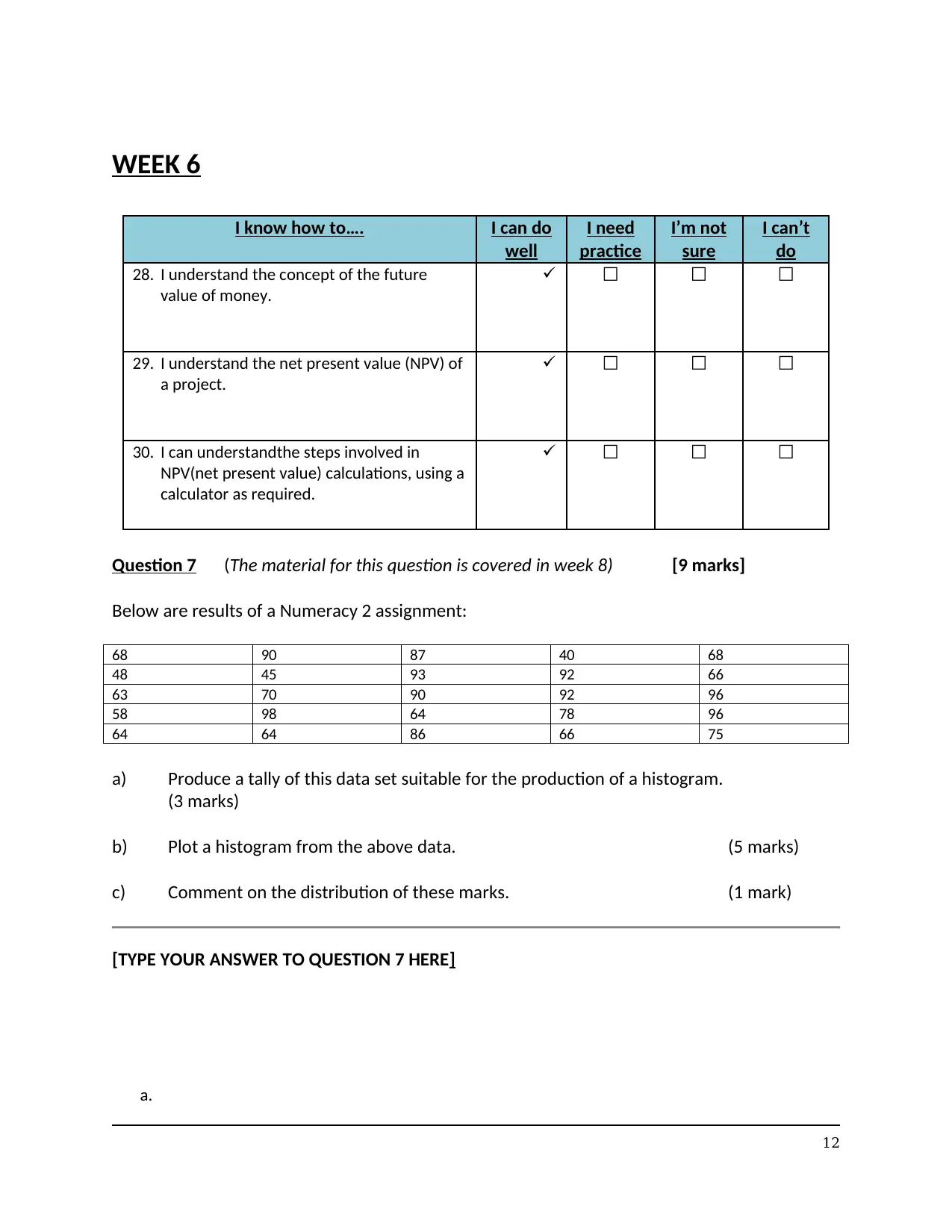
WEEK 6
I know how to…. I can do
well
I need
practice
I’m not
sure
I can’t
do
28. I understand the concept of the future
value of money.
☐ ☐ ☐
29. I understand the net present value (NPV) of
a project.
☐ ☐ ☐
30. I can understandthe steps involved in
NPV(net present value) calculations, using a
calculator as required.
☐ ☐ ☐
Question 7 (The material for this question is covered in week 8) [9 marks]
Below are results of a Numeracy 2 assignment:
68 90 87 40 68
48 45 93 92 66
63 70 90 92 96
58 98 64 78 96
64 64 86 66 75
a) Produce a tally of this data set suitable for the production of a histogram.
(3 marks)
b) Plot a histogram from the above data. (5 marks)
c) Comment on the distribution of these marks. (1 mark)
[TYPE YOUR ANSWER TO QUESTION 7 HERE]
a.
12
I know how to…. I can do
well
I need
practice
I’m not
sure
I can’t
do
28. I understand the concept of the future
value of money.
☐ ☐ ☐
29. I understand the net present value (NPV) of
a project.
☐ ☐ ☐
30. I can understandthe steps involved in
NPV(net present value) calculations, using a
calculator as required.
☐ ☐ ☐
Question 7 (The material for this question is covered in week 8) [9 marks]
Below are results of a Numeracy 2 assignment:
68 90 87 40 68
48 45 93 92 66
63 70 90 92 96
58 98 64 78 96
64 64 86 66 75
a) Produce a tally of this data set suitable for the production of a histogram.
(3 marks)
b) Plot a histogram from the above data. (5 marks)
c) Comment on the distribution of these marks. (1 mark)
[TYPE YOUR ANSWER TO QUESTION 7 HERE]
a.
12
⊘ This is a preview!⊘
Do you want full access?
Subscribe today to unlock all pages.

Trusted by 1+ million students worldwide
1 out of 17
Related Documents
Your All-in-One AI-Powered Toolkit for Academic Success.
+13062052269
info@desklib.com
Available 24*7 on WhatsApp / Email
![[object Object]](/_next/static/media/star-bottom.7253800d.svg)
Unlock your academic potential
Copyright © 2020–2025 A2Z Services. All Rights Reserved. Developed and managed by ZUCOL.
![Business Numeracy Portfolio Assignment - Weeks 1-8 - [University Name]](/_next/image/?url=https%3A%2F%2Fdesklib.com%2Fmedia%2Fimages%2Fol%2Fc8b0710628094746a512982ff40e7887.jpg&w=256&q=75)




